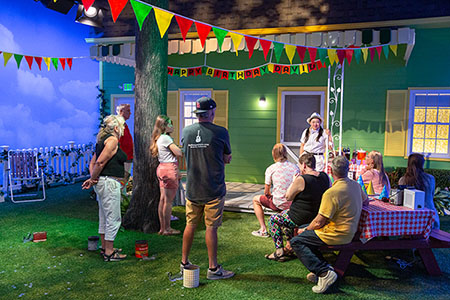
A new Chicago ordinance now allows Additional Dwelling Units, or ‘Granny Flats,’ to be built citywide, signaling a significant step toward addressing Chicago’s affordable housing shortage.
(Above) A coach house (left in photo) in Chicago’s Old Town neighborhood. Click on image to view larger version. ADU photos by Don DeBat. Oct. 15, 2025 – “Granny Flats” finally are rising out of their rocking chairs in Chicago, a world-class city that is desperate for construction of new affordable housing. Thousands of basement, attic, and coach-house dwellings – officially known as Additional Dwelling Units (ADUs) – now are considered legal housing almost citywide following the passage of a compromise plan by the Chicago City Council.
In 1947, during the great housing shortage following World War II, tens of thousands of living units were created citywide in existing apartment buildings to house returning veterans and their families. In the then-blue-collar Old Town, and throughout the city, many three-flats were transformed into six-flats, with shared bathrooms and often only one exit. Any building with a dry basement was considered prime living space. Rent typically ranged from $16 to $20 a month. Today, North Side landlords are charging $1,000 to $1,800 a month for a grandfathered-in and nicely decorated one-bedroom basement unit with off-street parking. Typically, the rent – which is up to 30 percent below above-grade apartments – may include electricity, gas, and heat as utilities usually are tapped off the building’s main service connections.
When the city drafted a comprehensive zoning ordinance in 1956, essentially, new basement, attic, and coach-house units were forbidden, although existing units were grandfathered-in because the vast World War II housing shortage persisted. On September 25, 2025, a compromised version of a long-stalled ordinance to allow ADUs to be built citywide with certain restrictions and without requiring a zoning change was approved by the full City Council. The ordinance grew out of a limited pilot program established in 2021 that allowed additional dwelling unit construction in five target areas on the North, Northwest, West, South, and Southeast sides. Property owners in single-family home districts already included in the existing pilot zones will still be allowed to build coach houses and other approved ADU units. The City Council voted unanimously in support of the amended plan, which passed after the original sponsor, 44th Ward Alderman Bennett Lawson, made numerous concessions to the legislation’s most vocal critic, Southwest Side Alderman Marty Quinn (13th Ward). Luxury property owners are comfortable with ADU housing The final ordinance allows additional dwelling units to be built without a zoning change in areas currently zoned for multi-unit buildings, as well as in business and commercial districts. However, properties in single-family zoning districts that are not included in the original pilot zones will not be allowed to build the additional units under the expansion, unless individual alderpersons decide to allow them through a separate ordinance for part, or all, of an impacted area. On top of those restrictions, the legislation requires contractors building new garages topped with a coach house apartment to participate in a United States Department of Labor apprenticeship program, a stipulation supported by organized labor leaders. Realtors in such hot housing neighborhoods as Old Town, Lincoln Park, and Gold Coast say that owners of luxury properties are amendable to have approved ADU housing.
ADU ordinance has restrictions The following restrictions on construction of the additional units that were part of earlier proposals are also included in the latest ordinance, if legalized in individual wards: • One additional dwelling unit would be allowed per block every year in residential districts zoned RS-1. • Two units would be allowed per block in districts zoned RS-2. • Three units would be allowed per block in districts zoned RS-3. • Homeowners may also be required to live in the house where they are seeking to build an additional unit. However, individual alderpersons could opt-out of those rules in their specific wards because Alderman Quinn insisted on the old-school City Council concept of “aldermanic prerogative.” Housing advocates have long argued the citywide expansion of ADUs is a relatively simple way to boost “gentle” density and add affordable housing across Chicago.
This new housing legislation could mean wide transformation of vacant storefronts and abandoned office spaces across the city into hundreds of new affordable housing units. |

















